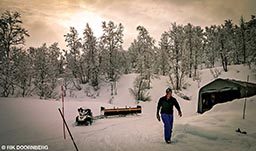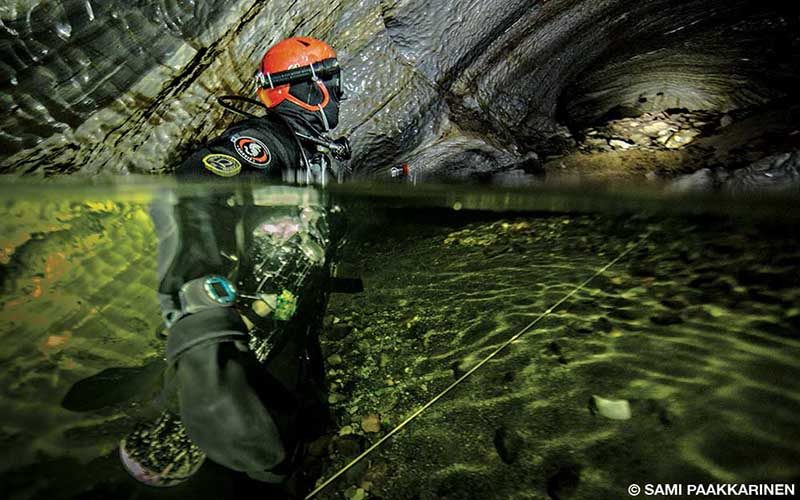The term cave diving often evokes places such as Mexico and Florida with their warm waters, relatively easy access and the ability to visit the nearest dive center for gas fills and some recommendations. For cave divers based in Sweden, however, pickings are rather slim but are no less rewarding for those who make the effort. Here is a description of a day of diving with Expedition Bjurälven in the continued exploration of Dolinsjö, Sweden’s longest underwater cave.
”Wake up! It’s 6:30 a.m., and breakfast is served! The sun is rising, and it is a crisp minus 30°C [minus 22°F] outside — another day in paradise,” Andreas gleefully calls out as he walks around and tries to shake life into 20 tired divers. He and Stina have been awake for more than an hour, making coffee and porridge to help smooth the day’s start. One by one, we roll out of our sleeping bags and make our way to the crowded little serving room in the old school that is our home in the Jämtland mountains for the week.

Everyone is in various states of soreness after shoveling snow, carrying dive gear and building camps for several days, but spirits are high as the sun rises over the snowclad landscape. I try to eat a double helping of porridge, boiled eggs and sandwiches in anticipation of a long day underground. Robert, Dmitri and I plan to take digital measurements of the furthest explored dry chamber in the cave, which will require several hours of diving, climbing and carrying to get there and back. We discuss some last-minute details over a second cup of coffee before it’s time for everyone to depart for the day’s activities.
After a short car ride higher up the mountain, we brave the freezing morning cold that lingers before the sun is properly up. We are greeted with big smiles from Stefan and Anders, two locals who are indispensable when it comes to snowmobile handling. It is well below minus 30°C as we transfer to the snowmobiles for a half-hour ride through some of Sweden’s most untouched nature. Even though I want to hide my face because of the cold, we all look around at the beauty.
We are a chilled bunch of explorers when we arrive at base camp. Everyone sets off like ants trying to get the basic chores done and to restore some warmth. On days like this, we first address the basic necessities: warmth, compressors and boiling water for more coffee. Øyvind starts the power generators (no small feat in the bitter cold) that in turn can warm up the heater, so we can finally get the compressor up to a decent temperature. Nothing works fast when temperatures are this low, but everyone is pulling toward the same goal, and we have done this dance many times now.

We decided the order of dive teams the night before, and because my team is going the farthest, we are first in the water. While we get our gear together, Marco, Lasse and Ola start to reopen the hole in the ice where we will start the dive. They saw through several centimeters of ice that formed during the night. I feel like a knight getting dressed for battle, clumsily trying to get the armor in place with help from Ane and Marcin. It is not easy to get into a harness half solid with ice while wearing every piece of thermals I own, and I look more like the Michelin Man than a knight. Getting help with all sorts of things before the dive is essential as we try to save energy, and it’s important not to sweat now because it will make me colder later on.
After exiting the dressing tent, I pass through the food tent that also works as a communications hub. On a big whiteboard I take a dot labeled with my name and move it from the base camp to the map of the cave close to the end where we are going. The board allows everyone to track where any member of the team is at any given time. I see that Micke, Pirre and Jonas have gone to our alternate camp at another cave entrance, where they are trying to find a connection to the main cave that we are exploring.
I stuff some chocolate bars and a thermos of hot chocolate into my drysuit pocket before we get in the water. We don our tanks, make our final checks at the surface, confirm our dive plan with the dive leader, Amanda, give a final OK and head off into the icy water. In single file we negotiate the entrance — a slightly narrow passage filled up with gravel in the bottom. Part of each year’s preparations is spending a few hours underwater digging to get in. Inside the passage rests a shovel in case anyone feels ambitious about widening it a little. We do not have any problems swimming through the winding passages with our sidemount tanks, and all three of us have taken this route many times. Down, up, around and through white limestone, the tunnel goes for about half an hour of swimming before we get to the first dry chamber. At the edge of the water another team has set up a rope where we can hang our stage tanks we have breathed so far to use again on the way out this afternoon.

We slowly crawl up a small slope with our tanks until we can stand and walk, with our backs bent, through the chamber. We typically do this with both tanks still clipped on, stopping only shortly to catch our breath in the largest room, where a perpetual waterfall cascades from the ceiling. I stop to check on the safety canister placed here two days before; it is filled with dry clothes, space blankets and chemical heaters. The second water passage (sump) is so short it takes about a minute to cross before it’s time to scramble on. The second chamber starts with a small climb, and I grab a guiding rope that David installed the day before so we can climb more easily with all the extra weight. All these little things make these long dives more manageable and hammer in the message that a big team can be a great help when working toward one goal.
The third sump marks a section of the cave that we typically swim slowly through, not because it is narrow or tricky, but because it is stunningly beautiful. We are not stopping here today — we still have a long way to go. We glide like seals on our bellies a few meters through the fourth chamber to the next sump. After a few more squeezes we surface at our goal for the day: a chamber we have half-jokingly named the “Don’t touch that rock” room. The name comes from this being a large collapse room where to pass you need to crawl over, under and around giant blocks of stone that have fallen from the ceiling. We have brought laser measuring equipment to make an accurate map of the room and look for any passages we might have missed on previous visits. Robert, the master of measurements, soon produces a tablet with the mapping program so he can instantly download the measurements and overlay them with a drawing of the room.

Dmitri and I climb wherever Robert directs us for the next few hours and help him find the right points to measure for the best result from every angle. It is a long and tedious job, but now the chocolate bars and hot chocolate come to good use. As we slowly make our way through the room, we further explore an especially muddy and low tunnel that shoots off in a promising direction, only to loop around and come out halfway up a wall in an already explored room. We also set up a radio beacon we brought with us. On the surface, Bosse and Mats are tracking our movements with a device Bosse has built for this purpose. After about 15 minutes we get a return signal telling us the measurements are done and they have an accurate GPS position. We can now overlay it with the manual measurements of the cave and get an even more accurate map.

Our tired group finally heads back to our dive gear to start the journey out. We are muddy and cold, and we still have about two hours of swimming and crawling until we see daylight again. We huddle together and quickly look at the map that Robert has put together on his tablet and decide it’s been a day well spent.
Our way out is fairly uneventful until we get close to the exit, where the visibility quickly drops. I glance up to a side tunnel that’s emitting a cloud of silt and see two lights. I remember from the planning the night before that Stefan and Kristian are probably up there trying to dig through a restriction. Chuckling a bit as we go through the cloud of silt they have created, we finally see daylight ahead. As we break the surface, we are greeted by a group of slightly sunburned explorers who have spent a few more hours outside today. The cold morning developed into a beautiful day in the mountains. I’m especially happy to greet Gunnel, a former teacher in the village where we stay and an invaluable asset because of her connections. Her presence in the camp often involves freshly baked cinnamon buns — quite a treat for tired cave divers.

Now we have only about one and a half hours to get out of our gear and make our way back to the cars. We do not want to get caught out on the mountain as the sun sets. If we have any issues that delay us and the dark creeps in, it would multiply the severity of the problems. What awaits us now is an evening of looking at measurements and leads the various teams have collected today and making a plan for tomorrow. Then maybe we can enjoy a quick sauna and, if we are lucky, some spectacular northern lights before bedtime.
Exploring Dolinsjö Cave
Bo Lenander first discovered Dolinsjö Cave in 1979 in a karst area in Bjurälven nature reserve in northern Sweden. He noted a small opening in the bottom of a small mountain lake while hiking and looking for caves in the area known for its many geologically interesting sites. Since 2007 there have been 11 expeditions to the area, all taking place in winter when the water flow is limited and transportation to the site can be made by snowmobile, because there are no roads.
After the 2018 expedition, the combined explored length of the underwater caves in the valley is more than 3 kilometers (1.86 miles), with the majority being in the Dolinsjö Cave. This latest expedition did a thorough search for a diveable entrance in the upstream area but was blocked by a treacherous-looking pile of fallen rocks. The team found, however, a new, promising and previously unexplored entrance just a few hundred meters from base camp. This cave immediately sets off in the direction of the other caves, and we hope to further explore this area when we return next year. Follow our progress on social media under Expedition Bjurälven.
Explore More
| © Alert Diver — Q3 2018 |